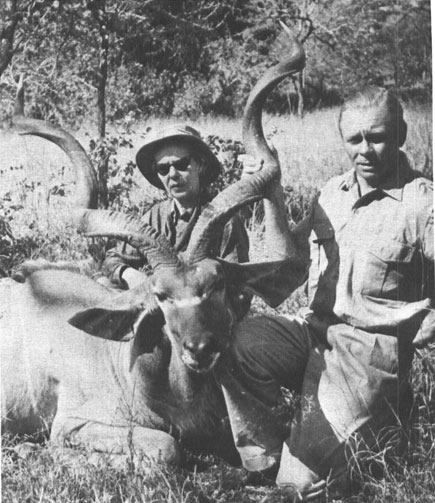

“I think,” says the author, “I've seen more game killed with fewer shots from this modest little cartridge than any other.” Here's the why and how, all of which may well explain the current spate of interest in the 7X57 as chronicled in the Gun Digest 1974 annual edition.
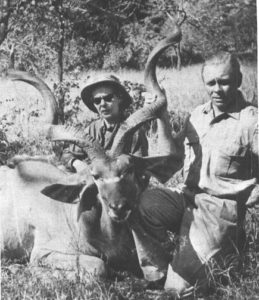
For almost 40 years I've been having an off-and-on romance with a sweet little cartridge known as the 7×57, the 7mm Mauser, and the 7mm Spanish Mauser. There is nothing spectacular about the 7×57. It does not have a big case. Even when the charge is tightly compressed it is possible to get only about 53 grains of 4350 or 4831 powders into the Western 7×57 case, which is roomier than Remington's. This modest little cartridge does not have a belt. It isn't a magnum. It doesn't bellow like a 105mm howitzer and scramble the brains of the firer. It doesn't shoot through three elk, one moose, two grizzlies and a forest ranger and then mow down a grove of jack pines on the far side. The hole in the barrel is so little that even a small, thin, underprivileged mouse would have difficulty in entering, and the cartridge itself isn't as long as a maiden's arm.
Yet I think I have seen more game killed with fewer shots from this modest little cartridge than with any other. The explanation for its deadly efficiency does not lie in blinding velocity, in big bullets, in a frightening number of foot pounds of energy. It lies in the light recoil, coupled with the excellent hunting accuracy of so many 7×57s. Those who use it are not afraid of it and, as a consequence, they tend to shoot it well—and to place their shots well. In case no one has told you, the most important factor in killing power is putting that bullet in the right spot.
The 7×57 is so-called because the bullet has the number of millimeters which add up to a diameter of .284″ and the barrels a bore diameter of .276″. The bullets have a slightly greater diameter than those of the 270 WCF, which measure .277″. The 7×57 case holds about 10 grains less powder, as you can stuff 62–63 grains of 4831 into a Western 270 case. The cartridge gets the “57” tacked onto its name because the case is 57mm long. The head size is the same as that of the 30-06 and the 270. It is simply the 8×57J Mauser case necked down to 7mm.
As I write this, late in 1972, the cartridge is 80 years old. Developed in 1892 at the Mauser Werke in Germany, it was adopted the next year by Spain as a military cartridge. We Americans first got acquainted with it in 1898 when, in Cuba, the Spanish used it to shoot small, neat holes in a considerable number of gringos in such ructions as the American charge up San Juan hill. The American army came out of the war with a profound admiration for the 7×57 and for the Model 1893 Mausers the cartridge was used in. American Ordnance developed the 1903 Springfield rifle, which is a modified Mauser, and the 30-03 and 30-06 cartridges, which are enlarged 7×57s.
Early History
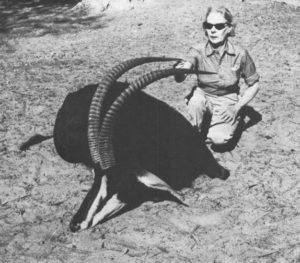
Until recent years, the 7×57 was enormously popular as a military cartridge. It was adopted by Mexico, Brazil, Colombia, Chile, Honduras, Uruguay, and Serbia, as well as by Spain. It became popular as a sporting cartridge in England, on the Continent, and in Africa. W.D.M. Bell, the famous elephant hunter and excellent writer (Bell of Africa, Tales of an Elephant Hunter, Karamojo Safari), used it with the full metal-jacketed 172-gr. military bullets (solids) to bump off over 1,000 elephants. Most of these were big, tough bulls with good ivory. Bell never bothered much with cows.
Americans became acquainted with the 7×57 as a big game cartridge after the Spanish-American War, as many American soldiers brought rifles back with them and used them on deer, elk, moose, and bear. For a long time the only American factory cartridge available was one loaded with a 175-gr. soft point bullet at a muzzle velocity of 2,300 foot seconds. Later the velocity was stepped up to 2,490 fps. I do not know, but I suspect that this velocity was taken in a 30-inch barrel as, until recently anyway, it was the practice to take velocities in the barrel length for which the cartridge was developed. In the case of the 7mm, the early military rifles had 30-inch barrels.
The long 175-gr. bullets gave satisfactory penetration because of good sectional density, made a satisfactory wound channel because the bullets had plenty of lead and expanded easily. All in all, with that bullet, the 7mm was a good 175–225 yard cartridge for about any sort of game. Trajectory with the heavy bullet was about like that of the 30-06 with the 220-gr. bullet. Recoil was less. If you were smart enough to sight in to put the bullet 3 inches high at 100 yards, there was no necessity to hold high even at 200—and I'm sure I don't need to tell my gentle readers that more game is killed at under 200 yards than over.
Along in the middle 1920s, the Western Cartridge Company shot the old 7mm full of testosterone and vitamins Z, P, and X, by bringing out a load that gave a 139-gr. open point bullet an alleged velocity of 3,000 fps. If that velocity were the McCoy (and I doubt that like hell) it was achieved in a 30-inch barrel. Remington likewise introduced a load with a 139-gr. bullet but said it was stepping along at 2,900. Prior to World War II, Winchester loaded a 150-gr. bullet at 2,750, a velocity probably taken in a 24-inch barrel. Currently Norma loads a 110-gr. bullet at 3,068, a 150 at 2,756, and a 175 at 2,490.
7×57 Actions
The 1893 and 1895 Mauser actions are on the soft side, cock on the closing motion of the bolt, and do not have the auxiliary locking lug at the root of the bolt handle. Pressures, consequently, should be kept down to around 45,000 pounds per square inch. Some of the actions made in Spain are particularly soft. Beginning around 1908, the Mauser Werke at Oberndorf, Germany, began turning out 7×57 sporters in various styles on a slightly shortened Model 98 type action. I have heard this action called the Model 1908 and also the Model 1912. It is, I believe, ⅜-inch shorter than the standard Model 98. Actions of similar, if not identical, lengths were used by Mexico, Czechoslovakia, and Yugoslavia. Just before and after World War I hock shops in the Southwest and Southern California always had for sale 7mm Mauser carbines that had probably come across the line with fugitive Mexican soldiers. These could be bought for a song and were widely used for hunting deer and desert sheep in the Southwest.
In Germany, .the Mauser Werke and various custom gunsmiths built 7×57s. In England, Rigby made them on Mauser actions, calling the cartridge the 275 Rigby. In the United States, Remington turned out 7×57 rifles on the Rider Rolling Block actions for various foreign governments, and also chambered Lee sporting rifles for the cartridge.
During the 1920s and 1930s, Griffin & Howe made many handsome sporters on Mauser and Springfield actions for the cartridge. The first caliber that W.A. Sukalle, the famous Arizona gunsmith and barrelmaker, tooled up for was the 7mm.
Remington chambered the Model 30 bolt action for the cartridge, and Winchester produced 7×57s in the Models 54 and 70. But what had been a mild boom for this fine little cartridge petered out. Both Winchester and Remington dropped the load with the 139-gr. bullet. They also discontinued the caliber in their line of bolt action rifles about the time WW II began.

However, in the past 20 years or so in the United States, thousands of 7×57 military rifles have been sold, turned into sporters in one way or another, and used for hunting. The cartridge has always had its admirers and hundreds of expensive custom sporters have been built for it. In 1972 Ruger made a few thousand 7×57 rifles in the Model 77 (as well as a near number of 257 Roberts rifles) and all were spoken for before they could be produced. The cartridge is a long way from being dead yet. Besides the regular load with the 175-gr. bullet, Federal Cartridge now loads a 139-gr. bullet; Dominion, one of the same weight. Velocities are in the neighborhood of 2,800 fps. Pressures are O.K. for the older Mausers. With both of these loads pressure is kept down to around 45,000 psi, I am sure, because most of them will be used in older rifles of the Model 93 type. The cartridge makes new converts every day. People like it because of its light recoil, its good killing power, and its good accuracy — not that you can't get bum 7mm barrels!
My First Little Seven
I got my first 7×57 rifle in 1934. I saw it at Bill Sukalle's shop in Tucson. Bill had put a 7×57 barrel on a remodeled action from a World War I German Model 98 Mauser sniper's rifle. It had been magnificently stocked in handsome French walnut by Adolph G. Minar of Fountain, Colorado, one of the finest classic stackers that ever lived. The stock had a German trap buttplate and a trap grip cap. It had as iron sights a Lyman 1-A peep on the cocking piece and a ramp front sight with gold bead. With iron sights, the rifle weighed slightly less than 7 pounds. However, it was equipped with a big German Gerard scope on claw mounts, which outfit added about two pounds. The scope was good optically, but because of the soft mount, it would not hold a constant point of impact. I traded the scope off. However, the rifle with iron sights was an astounding bargain at $75. That's right-$75! I took off the Lyman 1-A and had a 4x Noske scope put on with the Noske mount. The outfit then weighed less than 8 pounds.
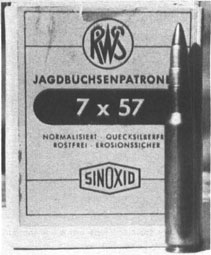
I shot my first desert ram with that rifle, one of the best Rocky Mountain mule deer I have ever knocked off, and various other game — all with the Western factory 139-gr. open point bullet load. With one exception, everything I shot at with a 7×57 was a one-shot kill. That was a desert mule deer which I shot in one ham as he ran directly away and on which I used two cartridges. Then about 1952, I caught up. Hunting on Idaho's Snake River with another 7×57, I picked out a nice fat doe and took a crack at her. Down the hill she rolled — and also a forkhorn buck that had been standing behind her.
Sadly enough, I traded off that lovely little Sukalle-Minar 7×57, along about 1940, for an equally handsome 2-R Lovell on a Sharps-Borchardt action. Like the 7×57, it had been barreled by Sukalle and stocked by Minar. The O'Connors felt civilization crowding in on them, moved away from Tucson to Lewiston, Idaho in 1948. Not long after I had Tom Burgess, a crack metal man (who was then in Spokane, but who's now located in Kalispell, Montana), remodel a Czech VZ33 action and fit a 22-inch 7×57 barrel. The late Russ Leonard made the stock. Before long, my wife latched onto it. I had the stock shortened and a recoil pad installed. This 7×57 has been her favorite rifle ever since. I have no idea how many North American animals she has collected with it, but I believe I can name the species — mule deer, Rocky Mountain goat, black bear, caribou, elk, Stone sheep, Dall sheep, Corsican mouflon in Texas, and pronghorn antelope. She has also used it on the mountain sheep called urial in Iran and has collected most of the African antelope — including such large ones as eland, greater kudu, roan, and sable — with it on safaris in Tanzania, Mozambique, Angola, Botswana, South West Africa and Rhodesia. When she went after tiger in India, and elephant and lion in Zambia, she felt she needed a very powerful rifle, so she acquired a 30-06. In Mozambique, our professional hunter was the famous Harry Manners. He looked askance at her little rifle, told her she was undergunned. Before the trip was over, he was calling her One-Shot Eleanor, because — with the exception of a greater kudu, a handsome antelope about the size of a spike bull elk — everything she shot at was taken with one bullet. This kudu jumped into the air as she fired, and I called it a heart shot. My wife hit it again as it ran and yet again when it stopped. It fell at the third shot, but it had one bullet through the heart. From its actions, I am convinced it was the first one.
In the summer of 1972 my wife, our son Bradford (who is the outdoor editor of The Seattle Times ) and I decided to make modest safaris in South West Africa and Rhodesia. Bradford took a Ruger Model 77 in 30-06 and a restocked Winchester Model 70 in 375 H&H. My wife and I did all of our shooting with two 7×57 rifles — her Mauser and my Model 70 Winchester.
Last Model 70 in 7×57
About that Model 70 in 7×57 there is a tale. It was the last 7×57 ever turned out at the Winchester factory. When I felt myself coming down with another 7×57 in 1955,1 asked friends at Winchester if they could put a Model 70 in that caliber together for me. I was told this was possible as they still had exactly one (1) 7×57 barrel left. When the rifle came I sent it to Al Biesen, the Spokane, Washington, gunsmith and stockmaker. He turned down the barrel, shortened it to 22-inches, put a release button for the hinged floorplate in the trigger guard, checkered the bolt knob, made a stock of good French walnut, mounted a Weaver K4 scope on a two-piece Redfield mount. Complete with scope, this rifle weighs 7¾ pounds and will keep good bullets into less than an inch. Partly because of the light recoil, I shoot this rifle quite well. I would be hard put to imagine a much better mountain rifle. For the record, the serial number of this little dream is 361582. Prince Abdorreza Pahlavi of Iran has the next to the last Model 70 in 7×57 turned out at Winchester. He has used it extensively in Asia, Africa, Europe and North America. Likewise put together on special order, its number is 222222!
When my wife and I arrived in South West Africa in the summer of 1972, the professional hunters there told us we were undergunned — an opinion I had heard before. There, and in Rhodesia, we shot greater kudu, sable (in size midway between mule deer and elk), mountain zebra, gemsbok, and various other antelope. Most of the animals were anchored with the first shot.
I used the 140-gr. Nosler bullet in front of 45 grains of 4320. Velocity in my Model 70 with 22-inch barrel is 2,825. This is the velocity I get in the same rifle with the Dominion 139-gr. bullet load. The Federal load, with the 139-gr. bullet, produces somewhat less velocity.
For years my wife has used various 160-gr. bullets pushed by 52 grains of 4831. Velocity in the 22-inch barrel of her rifle is 2,660. As far as I can tell, this load shoots just as flat as the 180-gr. bullet in the 30-06 and kills just as well.
In South West Africa the only animal she did not kill with one shot was an enormous kudu bull with 60-inch horns. The bull was about 300 yards away and moving. She shot twice, paunched it, broke a hip. He went about 100 yards and fell. A good bull sable she shot in Rhodesia was quartering away. The 160-gr. Nosler bullet angled through and came to rest under the hide behind the right shoulder. It ran about 150 yards. Only one lung had been hit.
Tough African Antelope
I have heard many a fanciful tale about the incredible toughness of African antelope. After much prayer and meditation and ten African safaris I cannot for the life of me see that African game is any tougher than North American game. I have used as “light” rifles on safari the following calibers: 300 Weatherby, 30-06, 270, 7mm Remington Magnum, 338 Winchester Magnum and the 7×57. I have also used on heavier animals a 416 Rigby, a 450/400 Jeffery double rifle, a 450 Watts (the predecessor of the 458 Winchester) and various 375 magnums.
As far as I can tell the little 7×57 kills African antelope from the largest to the smallest just as well as any of the cartridges I have used. I have, for instance, shot greater kudu with a 300 Weatherby, a 30-06, a 375, a 7mm Remington Magnum, a 270 and a 7×57. All kill well if the bullet is well placed, but the hunter who paunches his animal or breaks a leg is generally in trouble with any of them.
Just before writing this I read a piece by a writer who dotes on the magnums more than I do. He uses the 7×57 as a dreadful example of the non-magnum. He says that “200 yards is close to the practical killing limit of the 7×57.”-He adds that this is because the energy has then fallen off to about 1,400 ft. pounds.
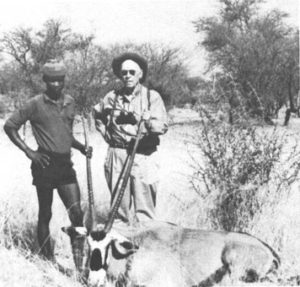
Well, I've got news for the lad. Two hundred yards is not only the practical killing range of the 7×57, but also the practical killing range of the 30-06, the 7mm Magnum, the 300 Weatherby Magnum, and what have you. The reason for this is that very few hunters can lay the bullets into the vital area of a game animal at any greater distance, even under the most favorable conditions. In fact, I'd bet a sugar cookie that most hunters could kill stuff farther away with the 7×57 than they could with the 7mm Magnum. It would not kick them so hard. They wouldn't be afraid of it, and they would shoot it better. I have some more news: game is not killed by foot pounds of energy. In fact, the energy has little to do with killing power. Animals are killed by putting in the right place a bullet that penetrates deep enough and opens up adequately.
Some of the most spectacular kills I have ever seen have been made with the 7×57. A very large mule deer, standing on a frosty hillside at about 8,000 feet above sea level in northern Arizona, was hit behind the shoulder and went over like a paper deer in a puff of wind. He was literally killed in his tracks. A greater kudu bull in South West Africa was hit through the upper leg bone and heart at about 150 yards. He fell as if he had been electrocuted. A Hartmann mountain zebra, that may have weighed 700 on the hoof, went down as if poleaxed when hit through the shoulder blade at about 275–300 yards. A sable in Rhodesia was hit too far back when trotting at about 250. It ran about 50 yards and stopped. I held slightly high (6–9 inches probably) and squeezed one off. The bull sable hit the deck.
I haven't made any very long shots with the 7×57, but I try to avoid long shots with any rifle. Most game is killed at 200 yards or less, but many of these kills get stretched out when they are processed through a typewriter.
I have never used a 7×57 to kill a bear of any sort — black, blue, brown, or grizzly. However, I saw the Storm & Strife knock off a nice black with one shot. I have never shot an elk with the 7×57, but I have seen her lay two good bulls low, each with one 7mm bullet, not to mention zebra, greater kudu, sable, roan, eland, four different kinds of sheep, and what-not.
Many very fine hunters have sworn by the 7×57.1 have mentioned W.D.M. Bell. That hunter of man-eating tigers, the late Capt. Jim Corbett, used a 7×57 (which he called a 275 Rigby) and a 450/400 Jeffery on these 400–500 pound cats. Prince Abdorreza Pahlavi has shot all sorts of Asiatic sheep and goats, all species of North American sheep, and most African antelope, with the Little Seven. One of the greatest sheep hunters who ever lived, the late Charlie Ren, used to shoot antelope and desert sheep with the 7×57 and the 300 Savage. He considered the 30-06 and the 270 too noisy, too violent, and too destructive, of meat. If a dude had ever shown up with a magnum I think old Charlie would have busted a gasket.
Shooting the 7×57
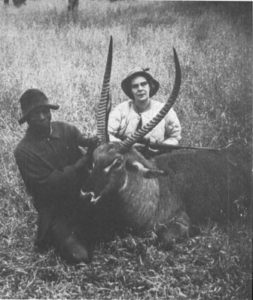
The 7×57 is a sweet little number to shoot. Recoil is about one-third less than that of the 270, about half that of the 7mm Remington Magnum. This is going to be a hard one for a lot of people to swallow: I have shot about the same amount of game with the 7×57 and the 7mm Magnum, and if, with the same shot placement, the magnum kills any better than the 7×57, I have been unable to see it.
The handloader will rejoice to learn that the 7×57 owner has his pick among a great variety of .284″ bullets. Speer alone makes bullets weighing 115, 130, 145, 160 and 175 grains. Nosler has three weights — 140, 160 and 175. Hornady can supply bullets in weights of 120, 139, 154 and 175 grains. The last can be had in either round nose or spire point styles. Anyone with a yen to shoot an elephant can usually scrounge up some old 175-gr. military “solids.”
Such lighter weight bullets as the 120-gr. Hornady and the 130-gr. Speer, which can be pushed along at velocities ranging from 2,900 to above 3,000, should be excellent for ante lope and open country deer. I have shot around 35–40 head of game ranging in size from Thompson gazelles (30 pounds) to greater kudu (600 pounds) and mountain zebra (700 pounds) with 140–145 grain bullets. No complaint. My wife has always stuck with one bullet weight — 160 grains. In her rifle this bullet leaves the muzzle at 2,660. She sights in for 200. The bullet drops 9 inches at 300. At 400, it would probably drop about two feet, but she doesn't believe in shooting at things that far away. She says doing so is silly. I'm inclined to agree with her.

Next Step: Get your FREE Printable Target Pack
Enhance your shooting precision with our 62 MOA Targets, perfect for rifles and handguns. Crafted in collaboration with Storm Tactical for accuracy and versatility.
Subscribe to the Gun Digest email newsletter and get your downloadable target pack sent straight to your inbox. Stay updated with the latest firearms info in the industry.

![Best Concealed Carry Guns In 2025 [Field Tested] Wilson Combat EDC X9S 1](https://gundigest.com/wp-content/uploads/Wilson-Combat-EDC-X9S-1-324x160.jpg)


![Best 9mm Carbine: Affordable PCCs [Tested] Ruger Carbine Shooting](https://gundigest.com/wp-content/uploads/Ruger-Carbine-Shooting-100x70.jpg)
![Best AR-15: Top Options Available Today [Field Tested] Harrington and Richardson PSA XM177E2 feature](https://gundigest.com/wp-content/uploads/Harrington-and-Richardson-PSA-XM177E2-feature-100x70.jpg)

I have to make a correction here that will not be popular – the 7×57 was never known in England or anywhere else as the “.275 Rigby”. It was known as the .275 (or .276). The cartridge has nothing to do with Rigby.
I think Jack O’Connor has conflated the Rigby-Mauser rifles that WDM Bell and Jim Corebet used with the cartridge name. When they say .275 Rigby, they are talking about the cartridge, followed by the rifle. Rigby’s Mauser sporting rifles were sold as their “Rigby-Mauser System”.
There is no such cartridge as a .275 Rigby, it’s not a real thing – but there were fine Mauser rifles chambered in .275 made by Rigby.
https://www.youtube.com/watch?v=yMFlCjf_J0w
I posted my own online comment below this video on Winchester’s Model 70 (new for the 21st
century) and chambered in 7mm Mauser (7×57). Were I to choose a dual purpose “deer/elk”
rifle it would be this one and topped with a quality 4x scope and carry sling.
—Jim Farmer, Ashland, Oregon
Great article; great cartridge. I made the mistake of selling my Winchester Model 70 Featherweight in 7×57, and spent years locating a replacement. Since these Winchesters are out of production, I also picked up a Remington Model 7 in 7-08 as its companion piece. I now take the latter into the field each deer season.
Good old Jack new what he was talking about and unlike the boys that beat the big bore drums for years Jack wrote from real practical experience. Lets face facts a 7×57 will shoot right through an elephant with the 175 grain loads and it will kill anything on the planet with that load. Do you really need a magnum even in a 7mm when the average hunting range is usually less than 200 yards. The 7×57 can easily reach out to 300 yds. which is about maximum for the skill level of the once a year hunter. For thin skin non dangerous game the lighter weight bullets will easily reach out to 600 yards if you are an accomplished shooter. The 7×57 barrel life can be as long as 8,000 rounds as opposed to the 2,000 rounds of a Rem 7mm Mag or 1,000 rounds of the super 7mm magnums like the 7mm stw. Faster and bigger is not always better and considering the recoil and muzzle blast factor faster and bigger is seldom better.